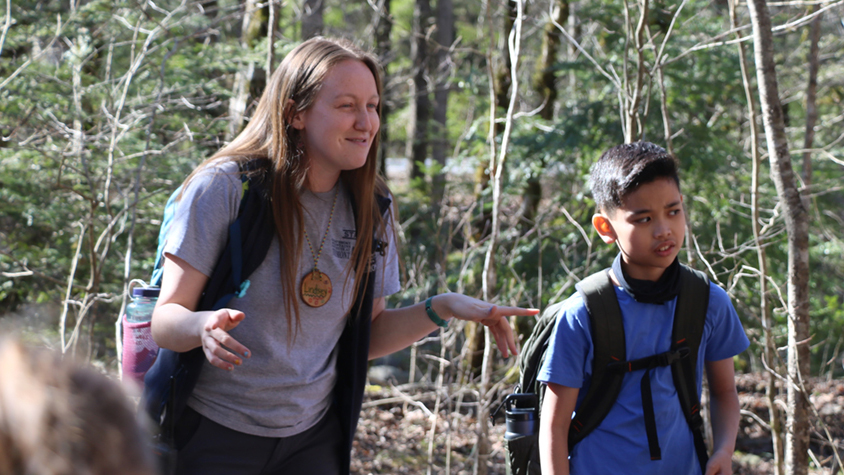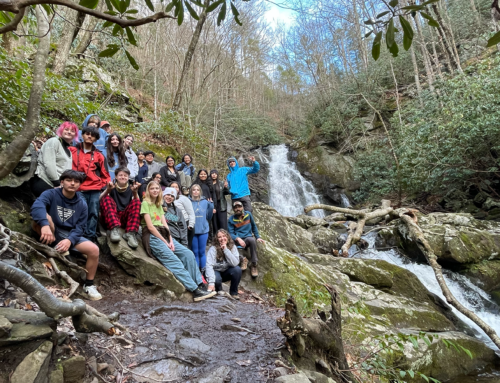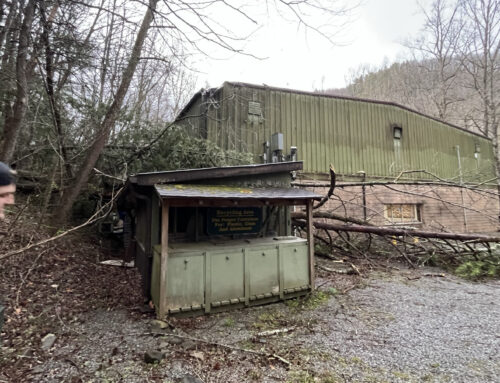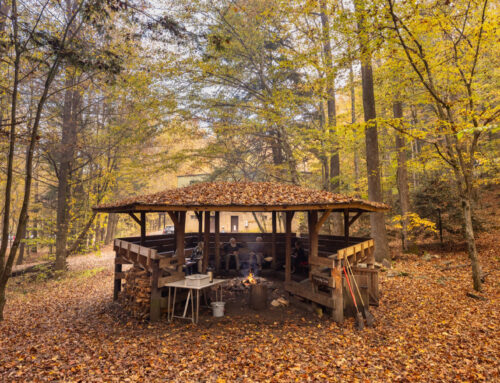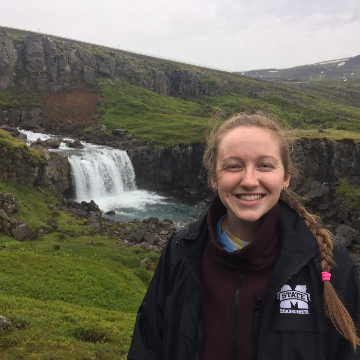 Tremont’s teacher naturalists are integral to our programs. They have the unique ability to both grab the attention of our school-age students and coax out feelings of curiosity and wonder in our adult learners. Megan Womack, development manager, sat down with Lindsey Kessler, teacher naturalist, to get an inside look at what makes our energetic, experienced teacher naturalists tick and how things are going in the first few months of 2022!
Tremont’s teacher naturalists are integral to our programs. They have the unique ability to both grab the attention of our school-age students and coax out feelings of curiosity and wonder in our adult learners. Megan Womack, development manager, sat down with Lindsey Kessler, teacher naturalist, to get an inside look at what makes our energetic, experienced teacher naturalists tick and how things are going in the first few months of 2022!
You’ve been back on campus and teaching since mid-January. How has the start of the year felt for you?
Lindsey: It’s been hectic and super busy! But it’s been fun. We’ve gone back to full capacity where we can take groups of 120 kids, so it gets a little crazy, a little loud. It’s been very fun. We had a number of Covid- and weather-related cancelations, especially at the beginning of the year, so it started off slowly but definitely built up.
So, when you say full-capacity, what does that mean? Are we bringing in groups of 120 kids every week now?
L: Full capacity means we’re able to fill all of the beds in the dorms. But we are only doing one group at a time, so right now we have a smaller group of 40. As of right now, we’re not bringing in concurrent groups, so if we have a group of 40, we won’t supplement other schools to reach capacity in dorms. It’s kind of nice—it’s a calmer week, which was sandwiched between two weeks of larger groups that fill up all the beds.
How does your teaching approach change between bigger groups and smaller groups?
L: Personally, when it’s a smaller group, there’s a lot more camaraderie amongst the kids and the teacher naturalists. We’re quicker to get to know each other—like, I might find out on the first day that a kid is really into salamanders, which their friends are learning about at the same time. So for the rest of the week, anytime we see a salamander, the whole group is calling that kid and saying, “Look at the salamander!” I get to connect more individually and I’m able to pivot faster based on their interests.
With larger groups, we’re focused on making sure everyone is in a sweet spot—they’re all doing the activity, but no one is struggling, no one is done and super bored. But one of the benefits of larger groups is going on an all-day hike and looking behind me to see this massive line of children traipsing through the woods. And campfires! Campfires with really big groups are wild, energetic… and so loud. But those are times when we want and welcome the excitement and chaos!

Any kids that you bonded with this past season?
L: Yeah, a couple of really fun interactions I had with kids that I’ll remember for a long time! There was one kid from a 6th-grade group, Scott, and he was so into sticks and anything related to sticks. But we have rules around sticks—namely, it can only be a stick. It can’t be a sword or a lightsaber, it’s a stick. Throughout the week, he’d find a stick that was his stick. A lot of the time we were searching for this perfect stick together. But inevitably, he’d do something where I’d have to take the stick. And then a few hours later, we’d try again, find another stick, repeat the cycle… and in the weirdest way, that was so much fun!
And then, on our all-day hike, he made it his mission to find the perfect hiking stick. And when he found it, he was so excited and couldn’t wait to put it to use. I don’t know, kind of a weird story about sticks!
That’s really remarkable that you’re able to connect with kids and bond with them on different levels most people wouldn’t consider.
L: Right, and I think about him all the time when I’m helping other kids find their perfect all-day hike stick. It was also neat to see the progression of learning. Like, the first time I had to take the stick away almost immediately because it quickly became a swordfight. But by the end of the week, on the all-day hike, I didn’t have to take it away at all. I’d say that’s an improvement!
I also encounter very powerful moments with kids who actively dislike being in the outdoors, and by the end of our time together, they say, “Hey, I might never do this again, but I’m really glad that I did it anyway.” I like helping kids discover any part of themselves—whether it’s a kid who falls in love with nature and wants to thru-hike the Appalachian Trail the minute they graduate or if it’s the kid who discovered that this isn’t their thing… I’m glad that I could be a part of it and their journey. But it’s always great to hear them say (and I’ve heard it three times at the end of all-day hikes), “This was the best day of my life. That was the coolest thing I’ve ever done, and I want to do this all the time.”
How about adults? What’s it like teaching your peers and elders?
L: My approach is pretty similar! On the front end, I’m always trying to prompt thought and wonder—why do you think, how do you think, what do you observe and see? There are differences in how I might explain the answer. But really, the biggest difference between teaching adults and kids is kids are way more willing to be wrong! Kids minds are very open to everything because they aren’t filled with pre-existing knowledge. Adults don’t always like to be corrected but it’s my job to help them broaden their perspectives and find different paths to their answer.
How are you continuing to educate yourself as a teacher naturalist while working as one?
L: I became a certified Wilderness Emergency Medical Responder! I’ve also been taking as many of Tremont’s SANCP classes that fit into my schedule and I’ve learned all sorts of great things that I get to use when I teach.
What’s the coolest thing you’ve learned in our SANCP courses?
L: I did the Geology course, which is an elective taught by Elizabeth. And she described how the Smokies were formed and why they’re the oldest in the world. These mountains are 1.4 billion years old and we’re still walking on that same sediment today. Are you for real?! They’ve found fossils of deep ocean dwellers at the top of mountains. Rocks are just wild and it’s crazy that I can hold millions of years right in my hands.
 What are you most excited about for the upcoming season?
What are you most excited about for the upcoming season?
L: River time and stream classes! This will be my first full year at Tremont, so I’m interested to see what factors mean it’s go-time to get back in the water with our participants. We haven’t been getting in the river since the very beginning of November and I’m ready.
I also can’t wait for training with our summer staff. We’re going to have a whole new team, I’m excited to have that full team and introduce them to what we do here at Tremont.
What do you think makes a great teacher naturalist?
L: Honestly, a TN has to have a great attitude and a lot of energy. It’s ideal that there’s experience working with kids, leading large groups, something with education or natural sciences, of course that helps. But more than that, if you’re energetic and excited to be in the mountains, psyched to hang out with kids, have a willing attitude to help out and try brand new things and get a little dirty? Those are the qualities that are really needed. It also helps when they’re kind and cool because that makes staff relations so much better! But usually a good attitude and energy makes a kind and cool person.
Let’s end on a fun note. What is your favorite tree in Great Smoky Mountains National Park? Be as broad or as specific as you want. Take some time to think about it!
L: That’s such a good question! I have the tree! There’s this Fraser Magnolia tree that’s on the side of Little River Road, halfway between the Townsend Wye and the Sinks. It’s the most perfect tree ever—a mature Fraser Magnolia that hangs out over the river. It gets so full in the summer, and has these massive, very big leaves. It stands out all by itself, a very stately tree. I haven’t actually walked up to it, but I keep an eye out for it. If I’m driving with someone, I point it out and I’m like, “Look at that tree, isn’t that a good tree?!” That’s my favorite tree.
Want to hear more from Lindsey? Check out this sound bite of her and the interviewers getting distracted by a bird mid-interview (in true naturalist fashion).


